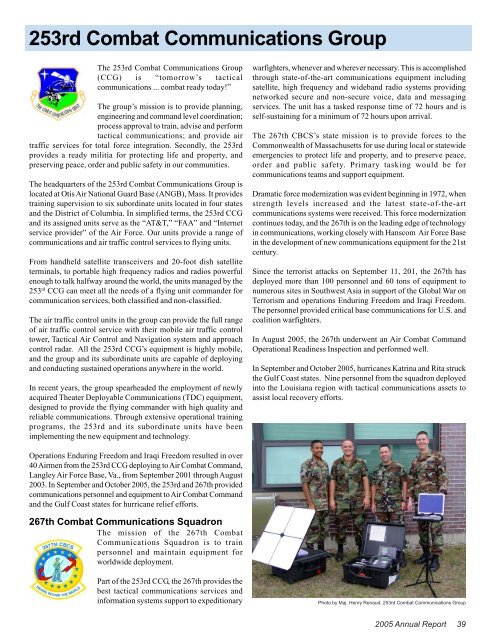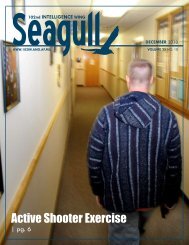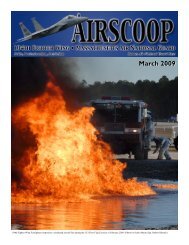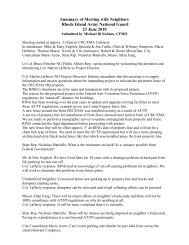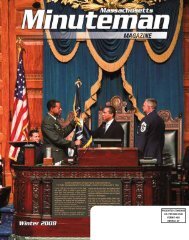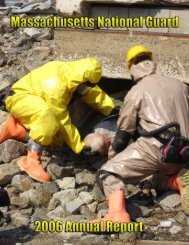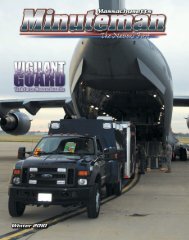FY05 Annual Report Final - STATES - The National Guard
FY05 Annual Report Final - STATES - The National Guard
FY05 Annual Report Final - STATES - The National Guard
You also want an ePaper? Increase the reach of your titles
YUMPU automatically turns print PDFs into web optimized ePapers that Google loves.
253rd Combat Communications Group<br />
<strong>The</strong> 253rd Combat Communications Group<br />
(CCG) is “tomorrow’s tactical<br />
communications ... combat ready today!”<br />
<strong>The</strong> group’s mission is to provide planning,<br />
engineering and command level coordination;<br />
process approval to train, advise and perform<br />
tactical communications; and provide air<br />
traffic services for total force integration. Secondly, the 253rd<br />
provides a ready militia for protecting life and property, and<br />
preserving peace, order and public safety in our communities.<br />
<strong>The</strong> headquarters of the 253rd Combat Communications Group is<br />
located at Otis Air <strong>National</strong> <strong>Guard</strong> Base (ANGB), Mass. It provides<br />
training supervision to six subordinate units located in four states<br />
and the District of Columbia. In simplified terms, the 253rd CCG<br />
and its assigned units serve as the “AT&T,” “FAA” and “Internet<br />
service provider” of the Air Force. Our units provide a range of<br />
communications and air traffic control services to flying units.<br />
From handheld satellite transceivers and 20-foot dish satellite<br />
terminals, to portable high frequency radios and radios powerful<br />
enough to talk halfway around the world, the units managed by the<br />
253 rd CCG can meet all the needs of a flying unit commander for<br />
communication services, both classified and non-classified.<br />
<strong>The</strong> air traffic control units in the group can provide the full range<br />
of air traffic control service with their mobile air traffic control<br />
tower, Tactical Air Control and Navigation system and approach<br />
control radar. All the 253rd CCG’s equipment is highly mobile,<br />
and the group and its subordinate units are capable of deploying<br />
and conducting sustained operations anywhere in the world.<br />
In recent years, the group spearheaded the employment of newly<br />
acquired <strong>The</strong>ater Deployable Communications (TDC) equipment,<br />
designed to provide the flying commander with high quality and<br />
reliable communications. Through extensive operational training<br />
programs, the 253rd and its subordinate units have been<br />
implementing the new equipment and technology.<br />
Operations Enduring Freedom and Iraqi Freedom resulted in over<br />
40 Airmen from the 253rd CCG deploying to Air Combat Command,<br />
Langley Air Force Base, Va., from September 2001 through August<br />
2003. In September and October 2005, the 253rd and 267th provided<br />
communications personnel and equipment to Air Combat Command<br />
and the Gulf Coast states for hurricane relief efforts.<br />
267th Combat Communications Squadron<br />
<strong>The</strong> mission of the 267th Combat<br />
Communications Squadron is to train<br />
personnel and maintain equipment for<br />
worldwide deployment.<br />
warfighters, whenever and wherever necessary. This is accomplished<br />
through state-of-the-art communications equipment including<br />
satellite, high frequency and wideband radio systems providing<br />
networked secure and non-secure voice, data and messaging<br />
services. <strong>The</strong> unit has a tasked response time of 72 hours and is<br />
self-sustaining for a minimum of 72 hours upon arrival.<br />
<strong>The</strong> 267th CBCS’s state mission is to provide forces to the<br />
Commonwealth of Massachusetts for use during local or statewide<br />
emergencies to protect life and property, and to preserve peace,<br />
order and public safety. Primary tasking would be for<br />
communications teams and support equipment.<br />
Dramatic force modernization was evident beginning in 1972, when<br />
strength levels increased and the latest state-of-the-art<br />
communications systems were received. This force modernization<br />
continues today, and the 267th is on the leading edge of technology<br />
in communications, working closely with Hanscom Air Force Base<br />
in the development of new communications equipment for the 21st<br />
century.<br />
Since the terrorist attacks on September 11, 201, the 267th has<br />
deployed more than 100 personnel and 60 tons of equipment to<br />
numerous sites in Southwest Asia in support of the Global War on<br />
Terrorism and operations Enduring Freedom and Iraqi Freedom.<br />
<strong>The</strong> personnel provided critical base communications for U.S. and<br />
coalition warfighters.<br />
In August 2005, the 267th underwent an Air Combat Command<br />
Operational Readiness Inspection and performed well.<br />
In September and October 2005, hurricanes Katrina and Rita struck<br />
the Gulf Coast states. Nine personnel from the squadron deployed<br />
into the Louisiana region with tactical communications assets to<br />
assist local recovery efforts.<br />
Part of the 253rd CCG, the 267th provides the<br />
best tactical communications services and<br />
information systems support to expeditionary Photo by Maj. Henry Renaud, 253rd Combat Communications Group<br />
2005 <strong>Annual</strong> <strong>Report</strong> 39


